

The origins of modern psychosurgery are to be found in the last decades of the 19th century, when science was beginning to understand how the human mind and behavior could be mapped out into the anatomical features of the brain. A German scientist named Friederich Golz, doing experiments with the surgical ablation of neocortex in dogs, reported in 1890 that when the temporal lobe were removed, animals were more tame and calmer than the unoperated ones.
This inspired Gottlieb Burkhardt, a physician and supervisor of an insane asylum in Switzerland, to perform in 1892 an operation to remove parts of the cortex of six schizophrenic patients which had hallucinations and became very agitated because of this. Some of his patients actually became calmer after the surgery, but we don't know whether this was a direct effect of the surgery (two of them died). Burkhardt was opposed and criticised by the medical authorities of his time, so that very few psychosurgeries of this kind were carried out in the next 40 years or so.
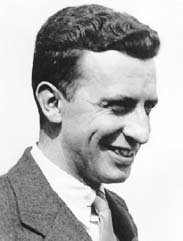 The situation changed again when several experimental laboratories in the USA started to
make amazing discoveries about the role of the temporal and frontal cortex in the control of emotional behavior
and aggressiveness. In Yale University, in 1935, a scientist named Carlyle Jacobsen made observations on the behavior
of chimpanzees after damaging their frontal and prefrontal cortex by means of a lobotomy ( "lobe cutting").
One of the animals, who was aggressive in certain situations before the surgery, became very calm and manageable.
This happened without apparent loss of other mental functions such as memory and intelligence. One of Yale's experimental
neurologists. Dr. John Fulton had also removed completely the frontal lobes of two chimpanzees, hereafter he was
unable to provoke a form of experimental neurosis in these animals.
The situation changed again when several experimental laboratories in the USA started to
make amazing discoveries about the role of the temporal and frontal cortex in the control of emotional behavior
and aggressiveness. In Yale University, in 1935, a scientist named Carlyle Jacobsen made observations on the behavior
of chimpanzees after damaging their frontal and prefrontal cortex by means of a lobotomy ( "lobe cutting").
One of the animals, who was aggressive in certain situations before the surgery, became very calm and manageable.
This happened without apparent loss of other mental functions such as memory and intelligence. One of Yale's experimental
neurologists. Dr. John Fulton had also removed completely the frontal lobes of two chimpanzees, hereafter he was
unable to provoke a form of experimental neurosis in these animals.
Because of this Fulton was to become one of the scientific pillars of the proponents of lobotomy in the United States.
John Fulton
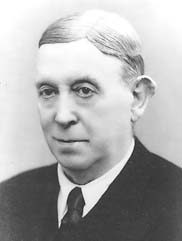 Upon hearing this from Fulton in a neurological conference in London, a Portuguese neuropsychiatrist,
Dr. Antônio
Egas Moniz, a professor at the University
of Lisbon Medical School, had the idea to perform a similar operation to alleviate some severe mental symptoms
of intractable psychoses. Egas Moniz knew that certain psychoses, such as paranoia and obsessive-compulsive disorders,
involve recurrent thought patterns that dominate all normal psychological processes. Based on Fulton's ideas, he
proposed to cut surgically the nerve fibers which connect the frontal and prefrontal cortex to the thalamus, a
structure located deep in the brain, which is responsible for relaying sensory information to the cortex. In this
way, Moniz reasoned, there might happen an interruption of the repetitive thoughts, allowing a more normal life
for the psychotic.
Upon hearing this from Fulton in a neurological conference in London, a Portuguese neuropsychiatrist,
Dr. Antônio
Egas Moniz, a professor at the University
of Lisbon Medical School, had the idea to perform a similar operation to alleviate some severe mental symptoms
of intractable psychoses. Egas Moniz knew that certain psychoses, such as paranoia and obsessive-compulsive disorders,
involve recurrent thought patterns that dominate all normal psychological processes. Based on Fulton's ideas, he
proposed to cut surgically the nerve fibers which connect the frontal and prefrontal cortex to the thalamus, a
structure located deep in the brain, which is responsible for relaying sensory information to the cortex. In this
way, Moniz reasoned, there might happen an interruption of the repetitive thoughts, allowing a more normal life
for the psychotic.
Antônio Egas Moniz
 Moniz, working with a neurosurgeon and colleague, Dr. Almeida Lima, developed a surgical
approach to the problem, which he called leukotomy ("white matter cutting"). He would open several
small holes by trepanning the two sides of the brain, and insert a special wire knife, called a leukotome into
the brain substance. With a few sideways movements, the fibers were severed and the patient could recover. Moniz
reported that the results were good in several patients. Severely agitated, anxious or depressive patients had
a general improvement in their symptoms, in some cases in a sriking way. In other patients, however, the operation
had no success, and Moniz was cautious to propose that leukotomy should be used only when the case was so hopeless
as to warrant it.
Moniz, working with a neurosurgeon and colleague, Dr. Almeida Lima, developed a surgical
approach to the problem, which he called leukotomy ("white matter cutting"). He would open several
small holes by trepanning the two sides of the brain, and insert a special wire knife, called a leukotome into
the brain substance. With a few sideways movements, the fibers were severed and the patient could recover. Moniz
reported that the results were good in several patients. Severely agitated, anxious or depressive patients had
a general improvement in their symptoms, in some cases in a sriking way. In other patients, however, the operation
had no success, and Moniz was cautious to propose that leukotomy should be used only when the case was so hopeless
as to warrant it.
After Moniz and his colleagues reported his results to the world (in six countries, simultanously) in 1936, several centers around the world started to try out the new surgery. In Brazil, the noted neurosurgeon Mattos Pimenta, from the Paulista School of Medicine, in São Paulo. was one of the first to perform Moniz leucotomies, with doubtful success.
So, probably prefrontal leucotomy would fizzle out (Moniz would retire early, after being shot in the spine by one of his ex-patients, becoming paraplegic) and be abandoned a few years after being invented. Many psychiatrists, particularly the psychoanalists were adamantly against it.
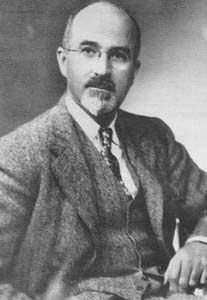 However, an ambitious American physician and clinical neurologist, Walter Freeman, attended
the same London conference as Moniz. Later he read Moniz's reports in the library. He became very excited with
the idea and his results, and teamed up with a neurosurgeon James Watts, to apply the newly invented technique
in American patients. They first operated in September 1936. After a few cases, he was convinced that leucotomy
worked, and started to propagandize it heavily. He was met with suspicousness and resistance by the bulk of American
neurosurgeons, but he insisted, eventually winning the reluctant approval of his colleagues. He and Watts perfectioned
the technique, arriving to what he called the "Freeman-Watts
Standard Procedure", which
had a precise set of guidelines for the insertion of the leukotome.
However, an ambitious American physician and clinical neurologist, Walter Freeman, attended
the same London conference as Moniz. Later he read Moniz's reports in the library. He became very excited with
the idea and his results, and teamed up with a neurosurgeon James Watts, to apply the newly invented technique
in American patients. They first operated in September 1936. After a few cases, he was convinced that leucotomy
worked, and started to propagandize it heavily. He was met with suspicousness and resistance by the bulk of American
neurosurgeons, but he insisted, eventually winning the reluctant approval of his colleagues. He and Watts perfectioned
the technique, arriving to what he called the "Freeman-Watts
Standard Procedure", which
had a precise set of guidelines for the insertion of the leukotome.
Walter Freeman
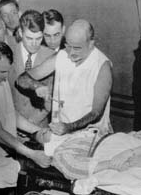
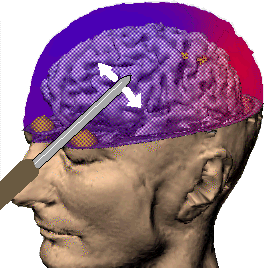 Freeman
was very good in convincing the general press about the promises of the prefrontal lobotomy (as he called it now),
and almost singlehandedly pushed it as a valid therapeutic procedure across the nation's insane asylums, hospitals
and psychiatric clinics. He also performed with Watts many operations around the country, but he was dissatisfied
with the messiness and length of the operation, Having heard about an Italian who had developed a trans-orbital
approach to the frontal lobe (i.e., by inserting a leucotome after making an opening in the roof of the eye orbits),
he invented in 1945 a much quicker and simpler way: the so-called "ice-pick lobotomy".
Instead of a leucotome, which required a surgical trepanning, he used a common tool to break ice, which could be
inserted under local anesthesia by tapping it with a hammer. The ice pick would perforate skin, subcutaneous tissue,
bone and meninges in a single plunge; and then Freeman would swing it to severe the prefrontal lobe. This would
take no more than a few minutes, with no need to intern the patient in the hospital. The procedure was so ghastly,
however, that even seasoned and veteran neurosurgeons and psychiatrists would not stand the sight of it, and sometimes
faint at the "production line" of lobotomies assembled by Freeman. James Watts became distressed with
this kind of operation and broke his ties with Freeman,
Freeman
was very good in convincing the general press about the promises of the prefrontal lobotomy (as he called it now),
and almost singlehandedly pushed it as a valid therapeutic procedure across the nation's insane asylums, hospitals
and psychiatric clinics. He also performed with Watts many operations around the country, but he was dissatisfied
with the messiness and length of the operation, Having heard about an Italian who had developed a trans-orbital
approach to the frontal lobe (i.e., by inserting a leucotome after making an opening in the roof of the eye orbits),
he invented in 1945 a much quicker and simpler way: the so-called "ice-pick lobotomy".
Instead of a leucotome, which required a surgical trepanning, he used a common tool to break ice, which could be
inserted under local anesthesia by tapping it with a hammer. The ice pick would perforate skin, subcutaneous tissue,
bone and meninges in a single plunge; and then Freeman would swing it to severe the prefrontal lobe. This would
take no more than a few minutes, with no need to intern the patient in the hospital. The procedure was so ghastly,
however, that even seasoned and veteran neurosurgeons and psychiatrists would not stand the sight of it, and sometimes
faint at the "production line" of lobotomies assembled by Freeman. James Watts became distressed with
this kind of operation and broke his ties with Freeman,
Lobotomy took America and some other countries by storm. They were performed in a wide scale in the 40s, because the mental asylums were brimming over with cases after the Second World War. Between 1939 and 1951, more than 18,000 lobotomies were performed in the United States, and tens of thousands more in other countries. It was widely abused as a method to control undesirable behavior, instead of being a last-resort therapeutic procedure for desperate cases. In Japan, the majority of the operated cases were children, many of whom had only problematic behavior or a bad performance at the school. Inmates in prisons for the insane were widely operated. Families trying to get rid of difficult relatives would submit them to lobotomy. Rebels and political opponents were treated as mentally deranged by authorities and operated. Amateur surgeons would often perform hundreds of lobotomies without even doing a systematic psychiatric evaluation.
In 1949, Dr. Antônio Egas Moniz was awarded the Nobel Prize for Medicine and Physiology, in recognition of his creation of the prefrontal leucotomy, This had the effect of making lobotomy a respectable procedure, and as a result, in the ensuing three years, more lobotomies were performed than in all previous years.
Finally, around 1950, the first discordant voices against the lobotomy folly started to be heard. Scientific evidence for the benefits of lobotomy was not coming. Even lobotomy's preponents admitted that only one third of the operated patients would improve, while one-third remained the same, and one-third got worst (25 to 30 % is the proportion of spontaneous improvement in many kinds of mental diseases ! Thus, a large proportion of the operated patients could have recovered without the lobotomy). In the United States, a major evaluation study called the Columbia-Greystone project was conducted in 1947 and failed to provide evidence of the positive effects of lobotomies. Many times, the evaluation was performed by the surgeons who did the work, without any kind of scientific controls.
Ethical objections began to pile up, because of the irreversible damage to the brain, and also because of the reports of severe collateral effects of the surgery on the personality and emotional life of the patients. In addition, the appearance of new antipsychotic and antidepressive drugs, such as Thorazine in the 50s, gave new means to combat most of the symptoms experienced by agitated and uncontrollable patients. Neurosurgeons everywhere started to abandon lobotomy in favour of more humane methods of treatment.
Concern over the protection of patients against lobotomy and similar radical therapies, particularly in inmates, where release was widely exchanged with agreement to a lobotomy (a highly unfair, biased and controversial offer); translated into laws in the United States in the 70s and in many other countries as well. Psychosurgery was classified as an experimental therapy, with many safeguards to the patient's rights.
The original lobotomy operation is now rarely performed, if ever, although many countries still accept psychosurgery as a form of radical control of violent behavior (Japan, Australia, Sweden and India are among them), In the Soviet Union, land of psychiatric abuse, lobotomy was outlawed in the 40s, not because it was not useful to suppress oponents of the Communist régime (they used other methods, such as forced hospitalization), but because there was a ideological stance against it.
 To Know More
To Know More
| From: The History of Psychosurgery Author: Renato M.E. Sabbatini, PhD Source: Brain & Mind Magazine, June 1997 |